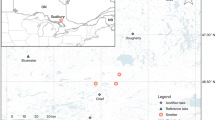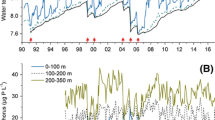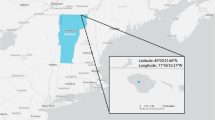Abstract
Alpine lakes of the Tatra Mountains were severely affected by acidification, with minimum recorded values of pH ∼4.5 in the mid-1980s. Since the 1990s, a dramatic decrease in the deposition of acidifying compounds has led to a considerable reversal in lake water chemistry (to pH∼5 in the most severely affected lakes). We studied changes of planktonic crustaceans and chironomid occurrence during the acidification period and the following period of recovery from acidification in three categories of 50 Tatra Mountain lakes (non-acidified, acidified and strongly acidified, according to their status at the beginning of the 1980s). In acidified and strongly acidified lakes, the planktonic crustaceans completely disappeared already by about 1976 except for a few individuals of ubiquitous species in littoral zone due to acidification-induced oligotrophication. In strongly acidified lakes, the original planktonic crustaceans disappeared and littoral species became more abundant already before 1976 due to acidification-induced eutrophication and aluminium toxicity. These processes were quickly reversed following the increase in lake water pH. Extinct species started to return to several acidified and strongly acidified lakes already in the beginning of 1990s. The process of recovery was delayed in many other lakes of the same categories, however, or it did not even start before 2008 despite the improved water chemistry and feeding resources (concentration of chlorophyll-a). Compared to planktonic crustaceans, the reaction of chironomids to acidification and recent recovery has been less pronounced. An analysis of sediment records showed that fluctuations in relative abundance of the dominant chironomid taxa and a decrease of their density occurred. In spite of the fact that chironomid fauna exhibited clear signs of recovery in the last two decades, the recovered assemblage does not exactly reflect the pre-acidification status in the lake. The occurrence and higher proportion of more thermophilous chironomid species in some alpine lakes of all categories could be correlated with increasing air temperature. The considerable effect of climatic factors may thus prevent the full re-establishment of the original status even when the acidification stress completely ceases. The delayed return of planktonic crustaceans to some recovered lakes could be a consequence of the short water residence time of these lakes. In addition, a shortening of the water residence time in recent decades, probably related to recent climate change, in interaction with the ecology of planktonic crustaceans, may possibly be causing further delays in their return.



Similar content being viewed by others
References
Almer, B., Dickson, W., Ekström, C., Hörnström, E., & Miller, U. (1974). Effect of acidification of Swedish lakes. Ambio, 3, 30–36.
Appleby, P. G., & Piliposian, G. T. (2006). Radiometric dating of sediment records from mountain lakes in the Tatra Mountains. Biologia, 61(Suppl. 18), S51–S64.
Benčoková, A., Stuchlík, E., & Křeček, J. (2009). Impacts of global climate change on the hydrological cycle in a small alpine catchment: the High Tatras, Slovakia. Acta Universitatis Carolinae, Environmentalica, 1–2, 33–43.
Battarbee, R. W., Shilland, E. M., Kernan, M., Monteith, D. T., & Curtis, C. J. (2014). Recovery of acidified surface waters from acidification in the United Kingdom after twenty years of chemical and biological monitoring (1988–2008). Ecological Indicators, 37, 267–273.
Bitušík, P., Svitok, M., Kološta, P., & Hubková, M. (2006). Classification of the Tatra Mountain lakes (Slovakia) using chironomids (Diptera, Chironomidae). Biologia, 61(Suppl. 18), S191–S201.
Bitušík, P., Kubovčík, V., Štefková, E., Appleby, P. G., & Svitok, M. (2009). Subfossil diatoms and chironomids along an altitudinal gradient in the High Tatra Mountain lakes: a multi-proxy record of past environmental trends. Hydrobiologia, 631, 65–85.
Bitušík, P., Šporka, F., & Krno, I. (2010). Benthic macroinvertebrate fauna of two alpine lakes over the last century: the value of historical data for interpreting environmental changes. Biologia, 65, 884–891.
Boggero, A., Füreder, L., Lencioni, V., Simcic, T., Thales, B., Ferrarese, U., et al. (2006). Littoral chironomid communities of alpine lakes in relation to environmental factors. In I. Lami, A. Boggero (eds), Ecology of High Altitude Aquatic Systems in the Alps. Hydrobiologia, 562, 145–165.
Brancelj, A., Kernan, M., Jeppesen, E., Rautio, M., Manca, M., Šiško, M., et al. (2009). Cladocera remains from the sediments of remote cold lakes: a study of 294 lakes across Europe. Advances in Limnology, 62, 269–294.
Brodin, Y.-W. (1990). Midge fauna development in acidified lakes in northern Europe. Philosophical Transactions of the Royal Society of London. Series B. Biological Sciences, 327, 295–298.
Brodin, Y.-W., & Gransberg, M. (1993). Responses of insects, especially Chironomidae, and mites to 130 years of acidification in a Scottish lake. Hydrobiologia, 250, 201–212.
Camarero, L., Rogora, M., Mosello, R., Anderson, N. J., Barbieri, A., Botev, I., et al. (2009). Regionalisation of chemical variability in European mountain lakes. Freshwater Biology, 54, 2452–2469.
Catalan, J., Pla, S., Rieradevall, M., Felip, M., Ventura, M., Buchaca, T., et al. (2002). Lake Redó ecosystem response to an increasing warming in the Pyrenees during the twentieth century. Journal of Paleolimnology, 28, 129–145.
Catalan, J., Barbieri, M. G., Bartumeus, F., Bitušík, P., Botev, I., Brancelj, A., et al. (2009). Ecological thresholds in European alpine lakes. Freshwater Biology, 54, 2494–2517.
Chomitz, K., & Šamaj, F. (1974). Precipitation characteristics. In M. Konček (Ed.), Climate of the Tatra Mountains (pp. 443–536). Bratislava: Veda.
Cosby, B. J., Wright, R. F., Hornberger, G. M., & Galloway, J. N. (1985). Modelling the effects of acid deposition: estimation of long term water quality responses in a small forested catchment. Water Resources Research, 21, 1591–1601.
Cosby, B. J., Ferrier, R. C., Jenkis, A., & Wright, R. F. (2001). Modelling the effects of acid deposition: refinements, adjustments and inclusion of nitrogen dynamics in the MAGIC model. Hydrology and Earth System Sciences, 5, 499–517.
Dupuis, L. V., Hann, B. J., & Paterson, M. (2015). Littoral cladoceran community reassembly following the cessation of disturbance. Journal of Paleolimnology, 54, 121–135.
Ertlová, E. (1987). Chironomids (Chironomidae, Diptera) of the littoral of the selected lakes in the high Tatras. Acta Facultatis Rerum Naturalium Universitas Comenianae – Zoologia, 29, 53–66.
Fott, J., Pražáková, M., Stuchlík, E., & Stuchlíková, Z. (1994). Acidification of lakes in Šumava (Bohemia) and in the High Tatra Mountains (Slovakia). Hydrobiologia, 274, 37–47.
Fott, J., Blažo, M., Stuchlík, E., & Strunecký, O. (1999). Phytoplankton in three Tatra Mountain lakes in different acidification status. Journal of Limnology, 52, 107–116.
Galas, J. (2004). Invertebrate communities of High mountain lakes (Polish Tatra Mts.). Teka Komisji Ochronyi Kształtowania Środowiska, 1, 57–63.
Grahn, O., Hultberg, H., & Lander, L. (1974). Oligotrophication—a self-accelerating process in lakes subjected to excessive supply of acid substances. Ambio, 3, 93–94.
Granados, I., & Toro, M. (2000). Recent warming in a high mountain lake (Laguna Cimera, Central Spain) inferred by means of fossil chironomids. Journal of Limnology, 59(Suppl. 1), 109–119.
Gregor, V., & Pacl, J. (2005). Hydrológia tatranských jazier. Acta Hydrologica Slovaca, 6, 161–187 [In Slovak].
Gunn, J. M., & Sandøy, S. (2003). Introduction to the Ambio special issue on biological recovery from acidification: Northern Lakes recovery study. Ambio, 32(3), 162–164.
Halvorsen, G. A., Heneberry, J. H., & Snucins, E. (2001). Sublittoral chironomids as indicators of acidity (Diptera: Chironomidae). Water, Air and Soil Pollution, 130, 1385–1390.
Havas, M., & Rosseland, B. O. (1995). Response of zooplankton, benthos, and fish to acidification: an overview. Water, Air and Soil Pollution, 85, 51–62.
Helliwell, R. C., Wright, R. F., Jackson-Blake, L. A., Ferrier, R. C., Aherne, J., Cosby, B. J., et al. (2014). Assessing recovery from acidification of European surface waters in the year 2010: Evaluation of projections made with the MAGIC model in 1995. Environmental Science & Technology, 48, 13280–13288.
Hořická, Z., Stuchlík, E., Hudec, I., Černý, M., Fott, J., & Kopáček, J. (2006). Acidification and the structure of crustacean zooplankton in mountain lakes: the Tatra Mountains (Slovakia and Poland). Biologia, 61(Suppl. 18), S121–S134.
Hrabě, S. (1940). Bentická zvířena tatranských jezer. Sborník Klubu Přírodovědců v Brně, 22, 1–13 [In Czech].
Hrabě, S. (1942). O bentické zvířeně ve Vysokých Tatrách. Bohemica, 25, 123–177 [in Czech].
Huser, B. J., & Rydin, E. (2005). Phosphorus inactivation by aluminium in lakes Gårdsjön and Härsvatten sediment during the industrial acidification period in Sweden. Canadian Journal of Fisheries and Aquatic Sciences, 62, 1702–1709.
IPCC. (2007). Climate change 2007: the physical science basis. In S. Solomon, D. Qin, M. Manning, Z. Chen, M. Marquis, K. B. Averyt, et al. (Eds.), Contribution of working group I to the fourth assessment report of the intergovernmental panel on climate change (p. 996). Cambridge: Cambridge University Press.
Ješková, K. (2004). Stratifikace zbytků perlooček v sedimentu tatranských jezer. MSc. thesis. Faculty of Science. Charles University in Prague. [In Czech].
Keller, W., Yan, N. D., Somers, K. M., & Heneberry, J. H. (2002). Crustacean zooplankton communities in lakes recovering from acidification. Canadian Journal of Fisheries and Aquatic Sciences, 59, 726–735.
Keller, W., Yan, N. D., Gunn, J. M., & Heneberr, J. (2007). Recovery of acidified lakes: Lessons from Sudbury, Ontario, Canada. Water, Air, and Soil Pollution, Focus, 7, 317–322.
Kopáček, J., Hejzlar, J., Stuchlík, E., Fott, J., & Veselý, J. (1998). Reversibility of acidification of mountain lakes after reduction in nitrogen and sulphur emissions in Central Europe. Limnology and Oceanography, 43, 357–361.
Kopáček, J., Stuchlík, E., Straškrabová, V., & Pšenáková, P. (2000). Factors governing nutrient status of mountain lakes in the Tatra Mountains. Freshwater Biology, 43, 369–383.
Kopáček, J., Ulrich, K. U., Hejzlar, J., Borovec, J., & Stuchlík, E. (2001). Natural inactivation of phosphorus by chemistry in atmospherically acidified water bodies. Water Research, 35(16), 3783–3790.
Kopáček, J., Hardekopf, D., Majer, V., Pšenáková, P., Stuchlík, E., & Veselý, J. (2004a). Response of alpine lakes and soils to changes in acid deposition: the MAGIC model applied to the Tatra Mountain region, Slovakia—Poland. Journal of Limnology, 63, 143–156.
Kopáček, J., Brzáková, M., Hejzlar, J., Nedoma, J., Porcal, P., & Vrba, J. (2004b). Nutrient cycling in a strongly acidified mesotrophic lake. Limnology and Oceanography, 49(4), 1202–1213.
Kopáček, J., & Stuchlík, E. (1994). Chemical characteristics of lakes in the High Tatra Mountains, Czechoslovakia. Hydrobiologia, 274, 49–56.
Kopáček, J., Stuchlík, E., & Wright, R. F. (2005). Long-term trends and spatial variability in nitrate leaching from alpine catchment-lake ecosystem in the Tatra Mountains (Slovakia—Poland). Environmental Pollution, 136, 89–101.
Kopáček, J., Borovec, J., Hejzlar, J., Kotorová, I., Stuchlík, E., & Veselý, J. (2006). Chemical composition of modern and pre-acidification sediments in the Tatra Mountain lakes. Biologia, 61(Suppl. 18), S65–S76.
Kopáček, J., Hejzlar, J., Kaňa, J., Norton, S. A., & Stuchlík, E. (2015a). Effects of acidic deposition on in-lake phosphorus availability: a lesson from lakes recovering from acidification. Environmental Science and Technology, 49, 2895–2903.
Kopáček, J., Bičárová, S., Hejzlar, J., Hynštová, M., Kaňa, J., Mitošinková, M., Porcal, P., Stuchlík, E., & Turek, J. (2015b). Catchment biogeochemistry modifies long-term effects of acidic deposition on chemistry of mountain lakes. Biogeochemistry, 125(3), 315–335.
Kopáček, J., Kaňa, J., Bičárová, S., Fernandez, I., Hejzlar, J., Kahounová, M., et al. (2017). Climate change increasing calcium and magnesium leaching from granitic alpine catchments. Environmental Science & Technology, 51, 159–166.
Kownacki, A., Galas, J., & Dymnivka, E. (1999). Invertebrate communities of high mountains lakes (Tatra Mountains) as acid pollution indicator. In G. G. Raddum, B. O. Rosseland, & J. Bowman (Eds.), Workshop on biological assessment and monitoring; evaluation and models, ICP waters report 50/1999 (pp. 57–60). Oslo: NIVA.
Krno, I. (1991). Macrozoobenthos of the Tatra lakes littoral (the High Tatras) and its affection by acidification. Biologia, 46, 495–506.
Krno, I., Šporka, F., Galas, J., Hamerlík, L., Zaťovičová, Z., & Bitušík, P. (2006). Littoral benthic macroinvertebrates of mountain lakes in the Tatra Mountains (Slovakia, Poland). Biologia, 61(Suppl 18), S147–166.
Kubovčík, V. (2004). The development of the aquatic ecosystem at Zmarzły Staw lake (High Tatra Mts., Polish), during last approximately 130 years. In Š. Kubík & M. Barták (Eds.), Dipterologica bohemoslovaca, 11 (pp. 163–172). Folia Facultatis Scientiarum Naturalis Universitatis Masarykianae Brunensis. Biologia. Brno.
Kubovčík, V., & Bitušík, P. (2006). Subfossil chironomids (Diptera: Chironomidae) in three Tatra Mountain lakes (Slovakia) on an acidification gradient. Biologia, 61(Suppl. 18), S215–S222.
Lajczak, A. (1996). Hydrology. In Z. Mirek, Z. Głowaciński, K. Klimek, & H. Piękoś-Mirkowa (Eds.), Przyroda Tatrzańskiego Parku Narodowego (pp. 169–196). Zakopane-Kraków: Tatrzański Park Narodowy [In Polish].
Lorenzen, C. J. (1976). Ultraviolet radiation and phytoplankton photosynthesis. Limnology and Oceanography, 24, 1117–1120.
Mackereth, F. J. H., Heron, J., & Talling, J. F. (1978). Water analysis: some revised methods for limnologists. FBA scientific publication no. 36. Kendal: Titus Wilson & Sons Ltda.
Minkiewicz, S. (1914). Przegląd fauny jezior tatrzańskich. Sprawozdania Komisyi fizyograficznej. Akademia Umiejętności w Krakowie, 48, 1–5 [In Polish].
Minkiewicz, S. (1917). Die Crustaceen der Tatraseen. Eine physiographisch-faunistische skizze. Sprawozdanie Komisyi Fizyograficznej. Akademia Umiejętności w Krakowie, Classe des Sciences Mathématiques et Naturelles, Série B, 262–278. [In German].
Monteith, D. T., Hildrew, A. G., Flower, R. J., Raven, P. J., Beaumont, W. R. B., Collen, P., et al. (2005). Biological responses to the chemical recovery of acidified fresh waters in the UK. Environmental Pollution, 137, 83–101.
Nedbalová, L., Stuchlík, E., & Strunecký, O. (2006). Phytoplankton of a mountain lake (Ľadové pleso, the Tatra Mountains, Slovakia): seasonal development and first indications of a response to decreased acid deposition. Biologia, 61(Suppl. 18), S91–S100.
Pšenáková, P. (1997). Mechanizmy ovlivňující koncentraci fosforu v acidifikovaných jezerech. Ph.D. thesis. Faculty of Science, Charles University in Prague. [In Czech].
Radwańska-Paryska, Z., & Paryski, W. H. (1995). Wielka encyklopedia Tatrzańska. Poronin: Wydawnictwo Górskie [In Polish].
Sacherová, V., Kršková, R., Stuchlík, E., Hořická, Z., Hudec, I., & Fott, J. (2006). Long-term change of the littoral Cladocera in the Tatra Mountain lakes through a major acidification event. Biologia, 61(Suppl. 18), S109–S119.
Skála, I. (2003). Faktory ovlivňující strukturu zooplanktonu ve vysokohorských jezerech. MSc. Thesis. Faculty of Science, Charles University in Prague. [In Czech].
Stangenberg, M. (1938). Zur Hydrochemie der Tatraseen. Verhandlungen des Internationalen Verein Limnologie, 8, 211–220.
Stuchlík, E., Stuchlíková, Z., Fott, J., Růžička, L., & Vrba, J. (1985). Effect of acid precipitation on waters of the TANAP territory. Treatises concerning the Tatra National Park, 26, 17–211 [In Czech].
Stuchlík, E., Appleby, P., Bitušík, P., Curtis, C., Fott, J., Kopáček, J., et al. (2002). Reconstruction of long-term changes in lake water chemistry, zooplankton and benthos of a small, acidified high-mountain lake: MAGIC modelling and paleolimnological analysis. Water, Air, and Soil Pollution, Focus, 2, 127–138.
Stuchlík, E., Kopáček, J., Fott, J., & Hořická, Z. (2006). Chemical composition of the Tatra Mountain lakes: response to acidification. Biologia, 61(Suppl. 18), S11–S20.
Stuchlíková, Z. (1991). Effect of previous feeding conditions on survival in Daphnia pulicaria (Crustacea: Cladocera). Hydrobiologia, 225, 177–183.
Szaflarski, J. (1935). Morfometrja jezior doliny Młynicy i niektórych stawów Wysokich Tatr. Tekst do Atlasu Jezior Tatrzańskich. Zbiorowe Prace Naukowe Koła Geografów U. U. J., Nr II B.: Kraków. [In Polish].
Szaflarski, J. (1936). Morfometria jezior tatrzańskich; Cz. I. Jeziora Tatr Polskich. Warszawa: Wiadomości Służby Geograficznej: Warszawa. [In Polish].
Šporka, F., Štefková, E., Bitušík, P., Thompson, A. R., Agustí-Panareda, A., Appleby, P. G., et al. (2002). The paleolimnological analysis of sediments from high mountain lake Nižné Terianske pleso in the high Tatras (Slovakia). Journal of Paleolimnology, 28, 95–109.
Štenclová, R. (2008). Vliv procesu zotavení z acidifikace na změny druhového složení zooplanktonu tatranských jezer. MSc. thesis. Faculty of Science. Charles University in Prague. [In Czech].
Tátosová, J., & Stuchlík, E. (2003). Chironomidae (Diptera) profundálu vysokohorských jezer (Vysoké Tatry, Slovensko) v různém stupni acidifikace. Acta Facultatis Ecologiae, Zvolen, 10(Suppl. 1), 193–196 [In Czech].
UN-ECE. (1999). Strategies and policies for air pollution abatement. Economic Commission for Europe (ECE.EB. AIR/65), Convention on Long-Range Transboundary Air Pollution, United Nations, New York and Geneva.
Vranovský, M., Krno, I., Šporka, F., & Tomajka, J. (1994). The effect of anthropogenic acidification on the hydrofauna of the lakes of the West Tatra Mountains (Slovakia). Hydrobiologia, 274, 163–170.
Vrba, J., Bojková, J., Chvojka, P., Fott, J., Kopáček, J., Macek, M., et al. (2016). Constraints on the biological recovery of the Bohemian Forest lakes from acid stress. Freshwater Biology, 61, 376–395.
Vyhnálek, V., Fott, J., & Kopáček, J. (1994). Chlorophyll-phosphorus relationship in acidified lakes of the High Tatra Mountains (Slovakia). Hydrobiologia, 274, 171–177.
Wright, R. F., & Dillon, P. J. (2008). Role of climate change in recovery of acidified surface waters. Hydrology and Earth System Science, 12, 333–335.
Zhou, Q., Driscoll, C. T., & Sullivan, T. J. (2015). Responses of 20 lake-watersheds in the Adirondack region of New York to historical and potential future acidic deposition. Science of the Total Environment, 511, 186–194.
Acknowledgments
This study was supported by the projects of Czech Science foundation SOIL and WATER (P503-14-09231S), the Slovak Scientific Grant Agency, VEGA (No. 2/0081/13) and by the project ITMS 26210120024. It is based on a long-term field and laboratory assistance of many students and colleagues, and we gratefully acknowledge their help. Special thanks belong to Jiří Kopáček for his manuscript revision.
Author information
Authors and Affiliations
Corresponding author
Electronic supplementary material
ESM 1
(PDF 357 kb)
Rights and permissions
About this article
Cite this article
Stuchlík, E., Bitušík, P., Hardekopf, D.W. et al. Complexity in the Biological Recovery of Tatra Mountain Lakes from Acidification. Water Air Soil Pollut 228, 184 (2017). https://doi.org/10.1007/s11270-017-3362-0
Received:
Accepted:
Published:
DOI: https://doi.org/10.1007/s11270-017-3362-0




